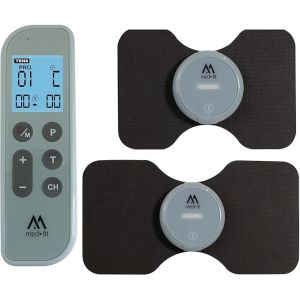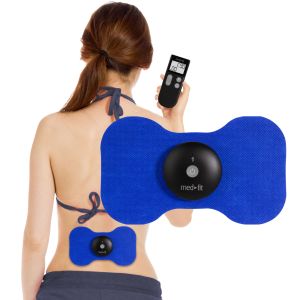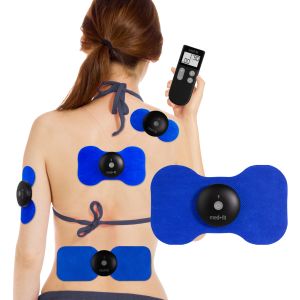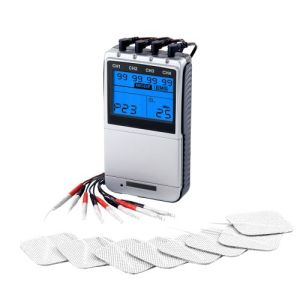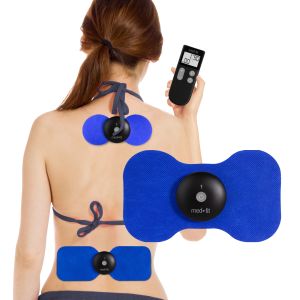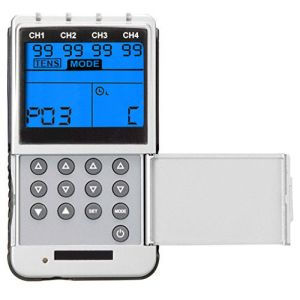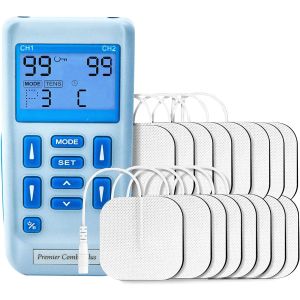Muscle Stimulators
5 reviews
from as low as £74.92
15 reviews
from as low as £49.95
Electrical Muscle Stimulators
Electrical muscle stimulator (EMS) machines send an electrical current through the body to stimulate muscles effectively. This is known as electrical muscle stimulation.
Muscle contraction occurs as a response to the electrical signals released by the brain, and EMS machines create similar electrical impulses to make the muscles contract intuitively.
Our team are always happy to help if you need any further information about EMS machines and what device is best for you. Give us a call on 0161 429 7330, or email us at sales@med-fit.co.uk, for support.
Differences Between EMS And A TENS Machine:
An electrical muscle stimulator (EMS) machine can trigger muscle contractions with the help of an electrical current. An EMS machine promotes muscle strength, and although it does offer some degree of pain relief - just as the TENS machine does - this is not the primary purpose of the stimulator.
EMS may help you strengthen weak muscles. The EMS can work on your muscle, helping it contract to its maximum, although about 30% of all muscle fibres contract at any given point in time. The remaining 70% of muscle fibres are usually dormant and only used when the other fibres suffer from fatigue. With EMS, you can potentially stimulate these dormant muscle fibres to increase strength.
Clinically, EMS is nearly more effective when the muscles are weak and you experience difficulty or discomfort whilst doing exercises.
EMS also works as an improvement tool for driving the speed of motor unit activation. This contraction pattern is etched as your "memory engram". Once your muscles are recruited often, your body continues to find the most effective ways to recruit those muscles. EMS can trigger repeated contractions to accelerate this process.
On the other hand, the primary purpose of a TENS (Transcutaneous Electrical Nerve Stimulator) machine is to alleviate pain and reduce muscular spasms. As such, it is often considered to be a preferred pain reliever - it allows users to deliver pain management but without the need for medication.
A TENS machine works by releasing electric impulses, which stimulate the nerve pathways and subsequently reduce the pain signals that are sent to the brain. TENS can be used to treat joint pain, nerve pain, muscle aches, injuries, and it can even offer period pain relief. These machines also trigger the release of endorphins, known as the body's natural painkillers.
You can also buy devices that combine TENS and EMS machine features.
Tips For Muscle Stimulator Use:
- Target One Muscle Group At A Time: Muscle stimulators focus on one muscle group at any given point in time, so it's important that you pace yourself when using an EMS machine to ensure a measured approach is taken across all areas of your body, including quads, biceps, chest and back.
- Target One Limb At A Time: Stimulate your limb muscles, targeting them one at a time. Working on both limbs at the same time reduces the current passing through the muscles.
- Maximise Muscle Relaxation: You want the muscle to be at rest, with no stress or tension.
- Don’t Stimulate All Muscles Simultaneously: Every muscle has an antagonist muscle that pulls when the other pushes. One contracts when the other relaxes - for example, biceps are the antagonists of triceps. So, target biceps with EMS, but never target the triceps simultaneously. Work them separately, at different times.
- Place The Electrode Pads Accurately: If you place the electrode pads on your body incorrectly, you’re bound to affect the results and the effectiveness of the treatment. With that in mind, it's important to follow the EMS machine’s instructions.
- Don’t Skip Warming Up Before Using The EMS: Don’t use the EMS machine on cold muscles without warming them up first. Use gentle, short muscular contractions to get your muscles and their tissues ready for some powerful stimulations from the EMS. Hot showers help as a “pre-warm-up” tactic too.
Do Muscle Stimulators Burn Fat?
There's very little research and evidence to suggest that muscle stimulation devices are directly linked to weight loss. However, the technology involved is often associated with weight reduction, but this is usually because the use of the device is paired with exercising.
Electrical muscle stimulators do help to increase the general blood flow to the muscles during exercise - this is when the device is being used during the workout.
This type of therapy is called electrotherapy, and it can help athletes or gym-goers to train consistently throughout their regime because of the increased speed of their muscle recovery. During this process, users can in fact lose weight and maintain muscle tone more effectively with an electrical stimulation device.
Does a Muscle Stimulator Work?
The application of electrical current to muscles induces contractions. Repetitive EMS can strengthen and tone muscles to some degree. Electronic muscle stimulators function by delivering electrical signals to prompt muscle contractions, commonly utilized in physical therapy or rehabilitation.
Since the 1960s, physical therapists have utilized this training method to enhance and sustain muscle strength post-surgery. In the former Soviet Union, elite athletes observed notable improvements in strength, ranging from 30% to 40%, suggesting that this stimulation method might be more potent than exercise alone.
Medical professionals can recommend these devices to aid in muscle strength recovery following:
- A stroke
- Major surgery
- Serious injury
Can they help build muscle?
When incorporated into a workout routine, EMS (Electrical Muscle Stimulation) enriches the workout experience by inducing extra muscle contractions using electric impulses. The intent is to prolong muscle contraction beyond an athlete's natural capability, theoretically promoting accelerated muscle growth.
Athletes typically integrate EMS devices into their workout regimens, wearing them during exercises like squats, bench presses, lunges, and more. The EMS machine sends impulses that contract muscles, effectively extending the contraction duration. Athletes adjust the device to emit more robust pulses, enabling muscles to contract for extended periods, intensifying the workout and pushing muscles beyond their typical limits. This heightened effort surpasses the point of mental fatigue, potentially amplifying muscle growth and expediting training.
These devices prove beneficial for athletes and individuals seeking post-surgery recovery or pain management while maintaining their training routine. The devices offer the versatility to address either pain relief or muscle building by adjusting wavelengths and pulses.
Click here to find the top 3 best ems machines

